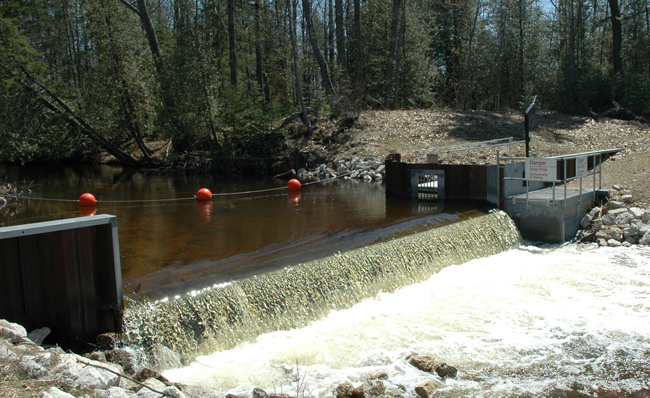By New York Sea Grant Launch Steward Julia Gilbert
New York Sea Grant 2012 Launch Stewards Program
Contact: Mary Penney, NY Sea Grant, E:
mp357@cornell.edu, P:315-312-3042
In an effort to control sea lampreys, the Great Lakes Fisheries Commission is currently constructing the first-ever fixed-crest, low-head barrier in New York State. It is located in Orwell Brook, off Hog Back Road in the town of Altmar in Oswego County.
The barrier, on private land and not publicly accessible, is a concrete dam with a center slot that will be seasonally blocked with aluminum stop blocks that create a 14-inch-high vertical barrier that sea lampreys cannot penetrate to reach upriver spawning areas. Atlantic salmon, steelhead, and other species, however, can jump over the barrier to get upstream.
In Lake Ontario, sea lampreys have been causing problems for not only host fish, i.e., the fish they prey on lake trout, whitefish and salmon, but for anglers of those prized sport fish. If you have ever been fishing in Lake Ontario and caught a beautiful brown trout with a red circle on its side, you have seen a sea lamprey wound.
The sea lamprey is a parasitic, slender fish native to the coastal regions of the northern United States along the Atlantic Ocean. According to Helen Domske and Chuck O’Neill, authors of the New York Sea Grant fact sheet “Invasive Species of Lake Erie and Ontario,” it is believed the construction of the Erie Canal in the mid-1800s made it possible for sea lamprey to travel from the Atlantic Ocean to the Great Lakes.
Sea lampreys feed by latching onto host fish with suction mouths; their sharp teeth and toothed tongue bore a hole through the host fish’s skin. The lampreys then begin sucking out the blood and other bodily fluids of the fish. Their saliva keeps the host fish’s blood from clotting, preventing the wound from healing.
Studies by the New York State Department of Environmental Conservation (NYSDEC) on the Great Lakes have shown that an attack by a sea lamprey results in the death of six out of seven prey fish, directly from the loss of bodily fluids or from the secondary infection that occurs at the wound site. Other NYSDEC studies have shown that a single adult sea lamprey can kill up to 40 pounds of fish in one year.
Fish that survive a sea lamprey attack are extremely weakened and more vulnerable to future attacks from other lamprey or capture by more powerful predators. Lampreys, according to the United States Geological Survey (USGS), are responsible for a rapid decline in the number of lake trout in the later 1940s and 1950s and a factor in the extinction of lake trout from Lake Ontario.
Steve LaPan, NYSDEC Great Lakes Fisheries Supervisor at the Cape Vincent Fisheries Station, says the new barrier at Orwell Brook “only operates as a dam when it is sea lamprey spawning season.” When spawning season is complete for the lamprey, the stop blocks are removed which allows for relatively unhindered movement of aquatic organisms.
To learn more about sea lamprey control methods, such as the use of the chemical compound 3-trifluoromethyl-4-nitrophenol better known as TFM, traps, and for more information on different types of barriers, visit the
Great Lakes Fisheries Commission Web site.
For more information on controlling aquatic invasive species, see the Web site at
www.nyseagrant.org/ais or call New York Sea Grant at 315-312-3042.

The Great Lakes Fisheries Commission is constructing a low-head barrier on Orwell Brook to control sea lampreys. The Orwell Brook barrier will be similar but not exactly like the one seen here.
Photo: M. Siefkes, Great Lakes Fisheries Commission
This is the fifth in a series of articles by the New York Sea Grant Launch Stewards. The stewards are college students helping to educate water users and shoreline property owners about how they can help slow the spread of aquatic invasive species. The Launch Stewards located along Oneida Lake, the eastern shore of Lake Ontario, and at the Salmon River Reservoir are part of a statewide project. Learn more online at www.nyseagrant.org/ccd.